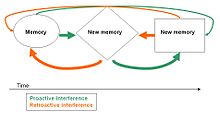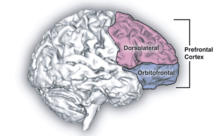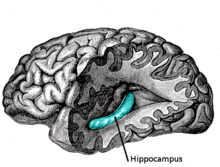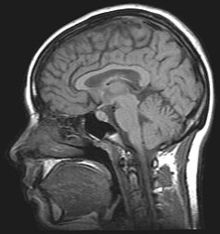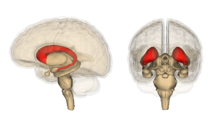- Interference theory
-
Contents
- 1 History
- 2 Proactive Interference
- 3 Retroactive Interference
- 4 Output Interference
- 5 Similar Theories
- 6 Neurobiology of Interference Theory
- 7 Application
- 8 See also
- 9 References
History
Bergström, a German psychologist, is credited as conducting the first study regarding interference in 1892. His experiment was similar to the Stroop task and required subjects to sort two decks of card with words into two piles. When the location was changed for the second pile, sorting was slower. This showed that the first sorting rules interfered with the learning of the new sorting rules.[1] German psychologists continued in the field with Georg Elias Müller and Pilzeker in 1900 studying Retroactive Interference. To the confusion of Americans at a later date Georg Elias Müller used associative Hemmung (inhibition) as a blanket term for retroactive and proactive inhibition.[1] The next major progression came from an American psychologist by the name of Benton J. Underwood in 1915. Underwood found that the more lists that were learned, the less the last-learned list was retained after 24 hours. These results were controversial because of the well known effect of the learning theory at the time.[2] In 1924, James J. Jenkins and Dallenback showed that everyday experiences can interfere with memory with an experiment that resulted in retention being better over a period of sleep than over the same amount of time devoted to activity.[2] The United States again made headway in 1932 with John A. McGeoch suggesting that decay theory should be replaced by an Interference Theory.[2] The most recent major paradigm shift came when Underwood proposed that proactive inhibition is more important or meaningful than retroactive inhibition in accounting for forgetting.[3]
Proactive Interference
Proactive Interference is the "forgetting [of information] due to interference from the traces of events or learning that occurred prior to the materials to be remembered".[4]
Proactive Interference occurs when in any given context, past memories inhibit an individual’s full potential to retain new memories. It has been hypothesized that forgetting from working memory would be non-existent if not for proactive interference.[5] A real life example of Proactive Interference is if a person had the same credit card number for a number of years and memorized that number over time. Then if the credit card was compromised, and a new card dispensed to the client, the person would then have great difficulty memorizing the new credit card number as the old credit card number is so ingrained in their minds.
Being compromised, and having difficulty in remembering new knowledge would mean that there is competition between the earlier knowledge and the new one (otherwise, the subject would not be able to remember new knowledge at all). If this is true, then it would mean that the magnitude of the interference should be directly proportional to the competing, earlier associations that the person has previously learned. Therefore, competition also includes items learned in the same shared context as the items that are currently being learned by the participants. If compared to Retroactive interference, studies show that Retroactive interference can have larger effects because of the fact that there is not only competition involved, but also unlearning.[6]
Proactive Interference with Single and Multiple Lists
Researchers have studied the joint influence of proactive and retroactive interference, within a single list. As expected, the recall of items is reduced by increasing the number of prior items or subsequent ones in a given list.[7] Besides, Proactive interference has a great effect on learning when dealing with multiple lists. In an experiment, researchers had participants learn a list of 10 paired adjectives.[8] The experimenters would consider learning as knowing eight of ten correct items on each trial. After two days, participants could recall close to 70% of the items. However, if asked to learn a new list (the day after learning the first one), then the 70% would decrease to 40%. If asked to learn a third list, then the probability of recall steadily fell to 25%. Therefore, Proactive interference affected the correct recall of the last list learned, because of the previous one, or two. In terms of forgetting, the effect of Proactive interference was proven by further studies using different methods. [9] It is worth noting that the effect of Proactive interference is reduced when the test is immediate and when the target list is obviously different from the previously learned lists.
Proactive Interference and Context
As previously introduced, proactive interference occurs with memories being learned in similar contexts. Even further, Proactive interference is also associated with poorer list discrimination, which occurs when participants are asked to judge whether an item has appeared on a previously learned list. [10] Moreover, if the items or pairs that are to be learned are conceptually related to one another, then Proactive interference has a greater effect.[11]
Brain Structures
The leading experimental technique for studying Proactive Interference in the brain is the “Recent-Probes” Task, in which participants must commit a given set of items to memory and they are asked to recall a specific item which is indicated by a probe.[12] Using the “Recent-Probes” Task, the brain mechanisms involved in the resolution of Proactive Interference have been identified as the ventrolateral prefrontal cortex and the left anterior prefrontal cortex. These influential areas of the brain have been identified through functional magnetic resonance imaging (fMRI).[13]
Research Concerning Proactive Interference
Span Performance
Span performance refers to working memory capacity. It is hypothesized that we have a limited span for performance in language comprehension, problem solving and memory.[14] Span performance on later experimental trials is worse than performance of earlier trials. This indicates that Proactive Interference affects susceptibility to span performance.[15] In a set of experiments, researchers were also able to find the different effects of Proactive interference when participants are given single or dual tasks: “working-memory capacity did, indeed, predict PI susceptibility”.[16] With single tasks, Proactive interference had less effect on high working memory span participants than low span ones. In terms of dual tasks, both types were similarly susceptible.
Researchers have also tried to examine the effect of Proactive Interference in the left inferior frontal context. For example, a subject is provided some material to hold in memory, and then a cue tries to “distract” the participant into forgetting what he currently had in mind. Just as in a normal test, a probe is then presented, and proactive interference can be assessed by analyzing whether the to-be-forgotten learned information will intrude. [17]
To differ, others have tried to investigate the relation of Proactive Interference when cued to forget. Turvey and Wittlinger designed an experiment to examine the effects of cues such as “not to remember” and “not to recall” with currently learned material. [18] While “not to remember” had a significant effect in reducing Proactive Interference, cued to “not to recall” previously encoded and stored information did not significantly reduce the effect. Therefore, these associated cues do not directly control the potential effect of Proactive Interference on short term memory span.
Moreover, Proactive interference has shown an effect during the learning phase in terms of stimuli at the acquisition and retrieval stages with behavioral tasks for humans, as found by Castro, Ortega and Matute. [19] With 106 participants, they investigated two main questions: if two cues are learned as predictors of the same outcome (one after the other), would the second-cue outcome association be retarded? And secondly, once the second association is fully learned, will there still be an effect on subsequent trials? The research, as predicted, showed retardation and impairment in associations, due to the effect of Proactive Interference.
Retroactive Interference
Retroactive Interference (RI) is a phenomenon that occurs when newly learned information interferes with and impedes the recall of previously learned information. [20] RI is a result of decreased recall of the primary studied functions due to the learning and recall of succeeding functions [21] RI is a classic paradigm that was first officially termed by [22]These memory research pioneers demonstrated that filling the retention interval (defined as the amount of time that occurs between the initial learning stage and the memory recall stage) with tasks and material caused significant interference effects with the primary learned items. An example of retroactive interference is a good skier having trouble skiing after learning to snowboard. The technique for snowboarding can interfere with the skiing technique causing the skier to have trouble remembering the earlier skill.
Important Classical Studies
Modified (free) Recall
Briggs (1954) study modeled McGeoch’s work on interference by setting the stage for a classic design of retroactive interference. In his study participants were asked to learn 12 paired associates to a criterion of 100%. To ensure parsimony, these pairs can be labeled as A1-B1-, A2-B2-…Ai-Bi (also called AB/AC paradigm). Briggs used a “modified free recall” technique by asking participants to recall an item when cued with Bi. Over multiple anticipation trials, participants learned Bi items through the prompt of Bi items. After perfecting Ai- Bi learning, participants were given a new list of paired associates to learn; however Bi items were replaced with Ci items (now given a list of A1-C1-, A2-C2-…Ai-Ci). As the learning of Ai-Ci pairs increased, the learning of Ai-Bi pairs decreased. Eventually recalling the Ci items exceeded the recall of the Bi items, representing the phenomenon of retroactive interference. A significant part of Briggs (1954) study was that once participants were tested after a delay of 24 hours the Bi responses spontaneously recovered and exceeded the recall of the Ci items. Briggs explained the spontaneous recovery illustration as an account of Ai-Bi items competing with Ai-Ci items or, as McGeoch would define it: “a resultant [of] momentary dominance” [23]
Modified Modified Free Recall
J.M. Barnes and B.J. Underwood (1959) expanded Briggs (1954) study by implementing a similar procedure. The main difference in this study, however, was that unlike Briggs (1954) “modified free recall” (MFR) task where participants gave one item responses, Barnes and Underwood asked participants to give both List 1 and List 2 responses to each cued recall task. Participants’ ability to recall both items was termed “modified modified free recall” (MMFR) technique. Equivocally to Briggs (1954) results, RI occurred when Ci recalled responses gradually came to exceed Bi responses. Barnes and Underwood argued that because there was “unlimited recall time” to produce multiple item responses, the fact that Ai-Ci responses still trumped Ai-Bi responses represented an account of unlearning. [24]
Theories of Retroactive Interference
The phenomenon of retroactive interference is highly significant in the study of memory as it has sparked a historical and ongoing debate in regards to whether the process of forgetting is due to the interference of other competing stimuli, or rather the unlearning of the forgotten material. The important conclusion one may gain from RI is that “forgetting is not simply a failure or weakness of the memory system” (Bjork, 1992), but rather an integral part of our stored knowledge repertoire. Although modern cognitive researchers continue to debate the actual causes of forgetting (e.g., competition vs. unlearning), retroactive interference implies a general understanding that additional underlying processes play a role in memory.
Competition
A standard explanation for the cause of RI is Competition. New associations compete with older associations and the more recent association would win out making it impossible to remember earlier associations. Spontaneous Recovery in MFR supports the claim of competition since after a rest period participants spontaneously remembered original pair associations that they were not able to remember right after the second test. [23]
Associative Unlearning
The Associative Unlearning Hypothesis explains RI by saying that new associations replace the old associations in memory causing the participant to forget the initial associations. Barnes and Underwood argued that Ai-Ci responses still outnumbering Ai-Bi responses after the delay period supports the Associative Unlearning Hypothesis over Competition. [24]
Brain Structures
Retroactive Interference has been localized to the left anterior ventral prefrontal cortex by magnetoencephalography (MEG) studies investigating Retroactive Interference and working memory in elderly adults.[25] The study found that adults 55–67 years of age showed less magnetic activity in their prefrontal cortices than the control group. Executive control mechanisms are located in the frontal cortex and deficits in working memory show changes in the functioning of this brain area.[25]
Research Concerning Retroactive Interference
Pitch Perception
Retroactive Interference has also been investigated using pitch perception as the learning medium.[26] The researcher found that the presentation of subsequent stimuli in succession causes a decrease in recalled accuracy.[26] Massaro found that the presentation of successive auditory tones, confused perceptual short term memory, causing Retroactive Interference as the new tone inhibits the retrieval of previously heard tones.[26]
Motor Movement
Wohldmann, Healey and Bourne found that Retroactive Interference also effects retention of motor movements.[20] Researchers found that retroactive interference effects the performance of old motor movements when newly acquired motor movements are practiced.[20] Physical practice of newly executed motor movements decreased the retention and recall of previously learnt movements.[20] Despite the retroactive interference noted by Wohldmann et al., researchers noted that mental practice decreased the amount of retroactive interference, suggesting that mental practice is more flexible and durable over time.[20] This study of the superiority effect of physical practice is similar to the Word Superiority Effect made famous by Cattell.[27]
Word Tasks
Retroactive Interference increases when the items are similar, therefore increasing association between them as shown by spreading activation.[28] Barnes and Underwood found that when participants in the experimental condition were presented with two similar word lists, the recollection of the first word list decreased with the presentation of the second word list.[28] This finding contrasts the control condition as they had little Retroactive Inference when asked to recall the first word list after a period of unrelated activity.[28]
Output Interference
Output Interference occurs when the initial act of recalling specific information interferes with the retrieval of the original information.[29] An example scenario in which Output Interference might occur would be if one had created a list of items to purchase at a grocery store, but then forgot to take the list when leaving home. The act of remembering a couple items on that list decreases the probability of remembering the other items on that list.
Research Concerning Output Interference
Short-Term Memory
Henry L. Roediger III and Schmidt found that the act of retrieval can serve as the source of the failing to remember, using multiple experiments that tested the recall of categorized and paired associative lists.[30] Three experiments were carried out where subjects were first presented with category lists and then asked to recall the items in the list after being shown the category name as a cue.[30] The further the test position from the category resulted in a decline of the recall of words. A fourth experiment revealed that only recent items were present in output interference in paired associative lists.[30]
Long-Term Memory
Smith found that if categories with corresponding items were successfully recalled, a systematic decline would occur when recalling the items in a category across the output sequence.[31] He conducted multiple experiments to determine the input conditioned necessary to produce Output Interference.[31] In his first experiment word recall per category was greater at 60 sec than 30 sec when taking the last input category out to prevent recency effect.[31] In his second experiment he changed the instructions, words used, and nature of the test for retention, and showed with recognition procedure, there was Output Interference but the effect was limited to the first three output positions.[31] Even if retrieving items is necessary for recall, it is not crucial to performance in a recognition tack.[31] Recall of the organized information from long-term memory had a negative effect on the following item recalled.[31] In long-term memory, Smith suggests that Output Interference has effects on extra-core material, which is represented as contextual information, rather than core material, which is highly available as a result of organization.[31] Both short and long term memories are centralized to the hippocampus and the amygdala.[citation needed]
Effects of Age
In both short-term memory and long-term memory Smith measured output interference in three age groups (aged 20–39, 40-59, 60–80 years).[32] The results of recall performance revealed significant differences due to age where the older group recalled fewer items than the middle group who recalled fewer items than the youngest group.[32] Overall Smith concluded that memory decline appears with increased age with long-term memory forgetting rather than short-term memory forgetting and short-term memory was unaffected by age. However output interference was unable to explain the memory deficit seen in older subject.[32]
Recent research of adult’s free recall and cognitive triage displayed similar findings of recall performance being poorer in older adults compared to younger adults.[33] Although it was also indicated that older adults had an increased susceptibility to output interference compared to younger adults and the difference increased as additional items were recalled.[33]
Similar Theories
Decay Theory
Decay theory outlines that memories weaken over time despite consolidation and storing.[34] This is to say that although you remember a specific detail, over time you may have greater difficulty retrieving the detail you encoded. It has been suggested that the time interval between encoding and retrieval determines the accuracy of recall.[35]
A practical example of Decay theory is seen in the financial sector. If you open a bank account and not deposit or withdraw money from the account, after a period of time the bank will render the account dormant. The owner of the account then has to reopen the account for it to remain active. The bank account (the memory) is rendered dormant (the memory weakened) over time if there is not activity on the account (if the memory is not retrieved after a period of time).
Comparing Decay and Interference Theory
Decay theory is similar to Interference Theory in the way that old memories are lost over time. Memories are lost in Decay Theory by the passing of time. In Interference Theory, memories are lost due to newly acquired memories. Both Decay and Interference Theories are involved in psychological theories of forgetting.
Contrasting Decay and Interference Theory
Decay and Interference Theory differ in that Interference Theory has a second stimulus that impedes the retrieval of the first stimulus. Decay Theory is caused by time itself. Decay Theory is a passive method of forgetting as no interference is produced.[36] Interference Theory is an active process because the act of learning new information directly impedes the recollection of previously stored information.
Dual Task Interfence
Dual Task Interference is a kind of interference that occurs when two tasks are attempted simultaneously. Harold Pashler from McMaster University in Hamilton, Ontario Canada wrote a paper summing up the theoretical approaches to Dual Task Interference.[37] The basis of his research looked at, when one attempts two or more tasks at the same time, why in some cases are they successful in completing their task and in other cases not.[37]
Capacity Sharing
Pashler proposed that the brain contains one mental entity to where all tasks must be carried out.[37] A real life example of this could be going to the dentist, the only place to have cavities filled is at a dentist’s office. When the brain is attempting to complete two tasks, both tasks are present in the same mind area and compete for processing ability and speed.[37] This relates to Interference Theory as the tasks compete. Interference Theory says that the learning of new information decreases the retrieval of older information and this is true in Dual Task Interference. The dominant task of the two, inhibits the other task from completion. It is presumed that the dominant task would be a new task as a previously accomplished task would already be stored in memory. The new task would then successfully be completed as more mind effort is required to complete a novel task and the previously completed task would not be completed as the new task dominated the mental capacity. Just as Interference Theory states, the completion of new tasks inhibits the completion of previously completed tasks due to capacity sharing.
Cross Talk Models
Cross talk is the communication between sensory inputs, processing and the thoughts of the individual.[37] The theory is that if two processes are being activated and they are not similar in any way (making cookies and going on vacation), the brain will be confused as separate cognitive areas are being activated and there is conflicting communication between the two.[37] Contrastingly, if the two processes are similar (making cookies and pouring milk), there will be less cross talk and a more productive and uninterrupted cognitive processing.[37]
Cross talk is used by engineers to discuss the degradation of communication channels due to context dependence.[37]
Navon and Miller claim that Dual Task Interference is caused by outcome conflict which is a result of one task producing, “outputs, throughputs, or side effects that are harmful to the processing of the [other task]".[38] This is basically the concept of Interference Theory. The thoughts, outputs and side effects of one task either effect the previous or subsequent recall.
Neurobiology of Interference Theory
Stroop and Simon Task
The performance of Stroop and Simon tasks were monitored on 10 healthy young adults using magnetic resonance image (MRI) scanning.[39] Functional images were acquired at specific time intervals during each subject's scan.[39] Brain activation during the Stroop and Simon task was remarkably similar including anterior cingulate, supplementary motor cortex, visual association cortex, inferior temporal cortex, inferior parietal cortex, inferior frontal cortex, dorsolateral prefrontal cortex, and caudate nuclei.[39] Interference effects in the Stroop and Simon tasks activate similar brain regions at similar time distributions.[39]
Application
Competitive Interference and Consumer Memory for Advertising
It has been demonstrated that recall will be lower when consumers have afterwards seen an ad for a competing brand in the same product class. Exposure to later similar advertisements does not cause interference for consumers when brands are rated on purchasing likelihood. This shows that information processing objective can moderate the effects of interference of competitive advertising. Competitive brand advertising not only interferes with consumer recall of advertising in the past but also interferes with learning new distinctive brand information in the future.[40]
Reducing Competitive Ad Interference
Repetition improves brand name recall when presented alone. When competitive advertising was presented it was shown that repetition provided no improvement in brand name recall over a single exposure. The competitive ads interfered with the added learning from repetition. However, when target brand name was showed using varying ad executions interference was reduced. Presenting ads in multi modalities (visual, auditory) will reduce possible interference because there are more associations or paths to cue recall than if only one modality had been used. This is the principle of multimedia learning. Also, interference is increased when competing ads are presented in the same modality. Therefore by presenting ads in multiple modalities the chance that the target brand has unique cues is increased.[41]
See also
References
- ^ a b Rieber, Robert W., Salzinger, Kurt D. (1998). Psychology: Theoretical-Historical Perspectives. Washington, D.C.: the American Psychological Association
- ^ a b c Hilgard R. Ernest. (1987). Psychology in America: A Historical Survey. Orlando, Florida: Harcourt Brace Jovanovich Inc.
- ^ Neel, Ann. (1969). Theories of Psychology: A Handbook. Cambridge, Massachusetts: Schenkman Publishing company, Inc.
- ^ Still, A.W. (1969). Proactive Interference and Spontaneous Alteration in Rats. The Quarterly Journal of Experimental Psychology, 21, 339-345.
- ^ Keppel, G., Underwood, B.J. (1962) Proactive Inhibition in short-term retention of single items. J Verb Learn Verb Behav, 1, 153-161
- ^ Melton, A.W., & Lackum, W. J. von. (1941). Retroactive and proactive inhibition in retention: evidence for a two-factor theory of retroactive inhibition. American Journal of Psychology, 54, 157-173
- ^ Murdock, B. B. (1963). Short-term retention of single paired associates. Journal of Experimental Psychology, 65, 433-443
- ^ Greenberg, R., & Underwood, B. J. (1950, Aug). Retention as a function of stage of practice. J Exp Psychol, 40 (4), 452-457
- ^ Underwood, B. J. (1957). Interference and forgetting. Psychological Review, 64, 49-60
- ^ Postman, L., & Keppel, G. (1977). Conditions of cumulative proactive inhibition. Journal of Experimental Psychology: General, 106 (4), 376-403
- ^ Underwood, B. J. (1983). Attributes of memory. Glenview, IL: Scott , Foresman
- ^ Jonides, J., Nee, D.E. (2006). Brain Mechanisms of Proactive Interference in Working Memory. Neuroscience, 139, 181-193.
- ^ Nee, D.E., Jonides, J., Berman, M.G. (2007). Neural Mechanisms of Proactive Interference-Resolution. Neuroimage, 38, 740-751.
- ^ May, C.P., Hasher, L., Kane, M.J. (1999). The role of interference in memory span. Memory and Cognition, 27, 759-767
- ^ May, C.P., Hasher, L., Kane, M.J. (1999). The role of interference in memory. Memory and Cognition, 27, 759-757
- ^ Kane, M. J, & Engle, R. W. (2000). Working memory capacity, proactive interference, and divided attention: Limits on Long term memory retrieval, Journal of Experimental Psychology: Learning, Memory, and Cognition 26 (2), 336-358
- ^ Jonides, J. & Nee, D.E. (2006). Brain Mechanisms of Proactive Interference in Working Memory, Neuroscience (139), 181-193
- ^ Turvey, M.T. & Wittlinger, R.P. (1969). Attenuation of Proactive Interference in Short-term Memory as a Function of Queuing to Forget. Journal of Experimental Psychology 80(2), 295-298.
- ^ Castro, L., Ortega, N. & Matute, H (2002). Proactive Interference in Human Predictive Learning. International Journal of Comparative Psychology (15), 55-68.
- ^ a b c d e Wohldmann, E.L., Healy, A.F., Bourne Jr., L.E. (2008). A mental practice superiority effect: Less retroactive interference and more transfer than physical practice. Journal of Experimental Psychology: Learning, Memory, and Cognition, 34, 823-833.
- ^ Underwood, B. J. (1948). ‘spontaneous recovery’ of verbal associations. Journal of Experimental Psychology, 38, 429-439.
- ^ Muller, G. E., & Pilzecker, A. (1990). Experimental contributions to memory theory. Zeitschrift fur Psychologie Eganzungsband, 1, 1-300.
- ^ a b Briggs, G. E. (1954). Acquisition, extinction, and recovery functions in retroactive inhibition. Journal of Experimental Psychology, 47, 285-293
- ^ a b Barnes, J. M> & Underwood, B. J. (1959). Fate of first-list associations in transfer theory. Journal of Experimental Psychology, 58, 97-105
- ^ a b Solesio, E., Lorenzo-López, L., Campo, P., López-Frutos, J.M., Ruiz-Vargas, J.M., & Maestú, F. (2009). Retroactive interference in normal aging: A magnetoencephalography study. Neuroscience Letters, 456, 85-88.
- ^ a b c Massaro, D.W. (1970). Retroactive Interference in Short Term Memory for Pitch. Journal of Experimental Psychology, 83, 32-39.
- ^ Cattell, J. M. (1886). "The time it takes to see and name objects". Mind, 11, 63-65
- ^ a b c Barnes, J.M. & Underwood, B.J. (1959). Fate of first list association in transfer theory. Journal of Experimental Psychology, 58, 97-105.
- ^ Tulving, E., & Arbuckle, T.Y. (1966). Input and output interference in short-term associative memory. Journal of Experimental Psychology, 72, 145-150.
- ^ a b c Roediger, H.L., III, & Schmidt, S.R. (1980). Output interference in the recall of categorized and paired associative lists. Journal of Experimental Psychology: Human Learning and Memory, 6, 91-105.
- ^ a b c d e f g Smith, A.D. (1971). Output interference and organized recall from long-term memory. Journal of Verbal Learning and Verbal Behaviour, 10, 400-408.
- ^ a b c Smith, A.D. (1975). Aging and Interference with Memory. Journal of Gerontology, 30, 319-325.
- ^ a b Marche, T.A., Howe, M.L., Lane, D.G., Owre, K.P., Briere, J.L. (2009). Invariance of Cognitive Triage in the Development of Recall in Adulthood. Memory, 17, 518-527.
- ^ Baddeley, A., Eysenck, M.W. & Anderson, A.C. (2009). Memory. New York, NY: Psychology Press
- ^ Brown, J. (1958). Some Test of the Decay Theory of Immediate Memory. Quarterly Journal of Experimental Psychology,10 , 12-21.
- ^ Grossberg, S. (1987) The Adaptive Brain: Vision, Speech, Language and Motor Control. Amsterdam, Netherlands: Elsevier
- ^ a b c d e f g h Pashler, H. (1994). Dual Task Interference in Simple Tasks: Data and Theory. Psychological Bulletin, 116, 220-244.
- ^ Navon, D & Miller, J.O. (1987). Role of outcome conflict in dual task interference. Journal of Experimental Psychology: Human Perception and Performance, 13, 438-448.
- ^ a b c d Peterson, B.S., Kane, M.J., Alexander, G.M., Lacadie, C., Skudlarski, P., Leung, H.C., Mat, J., Gore, J.C. (2002). An event-related functional MRI study comparing interference effects in the Simon and Stroop tasks. Cognitive Brain Research, 13, 427-440.
- ^ Burke, Raymond., Skrull, Thomas. (1988) Competitive Interference and Consumer Memory for Advertising. Journal of Consumer Research .Vol. 15: pp. 55-68
- ^ Unnava, H. Rao, Reducing Competitive Ad Interference , Journal of Marketing Research, 31:3 (1994:Aug.) p.403
Barnes, J.M., & Underwood, B.J. (1959). "Fate" of first-list associations in transfer
theory. Journal of Experimental Psychology, 58(2), 97-105.
Bjork, R. A. (1992). Interference and memory. In L. R. Squire (Ed.), Encyclopedia of
learning and memory (pp. 283-288). New York: Macmillan.
Briggs, G.E. (1954). Acquisition, extinction, and recovery functions in retroactive
inhibition. Journal of Experimental Psychology, 47(5), 285-293.
McGeoch, J.A. (1932). Forgetting and the law of disuse. Psychological review, 39(4),
352-370.
Melton, A.W., & Irwin, J.M. (1940). The influence of degree of interpolated learning on
retroactive inhibition and the overt transfer of specific responses. The American
Journal of Psychology, LIII(2), 611-641.
Müller, G.E., and Pilzecker, A. (1900). Experimentelle beiträge zur lehre von gedächtnis.
Zeitschrift für Psychologie 1, 1-300.
Salon, Heather. (2011). Dave Farrow: mind over memory. Retrieved from
http://www.cbn.com/700club/guests/bios/Dave_Farrow012909.a
Underwood, B.J. (1948). 'Spontaneous recovery' of verbal associations. Journal of
Experimental Psychology, 38(4), 429-439.
Categories:- Memory
- Memory processes
Wikimedia Foundation. 2010.

